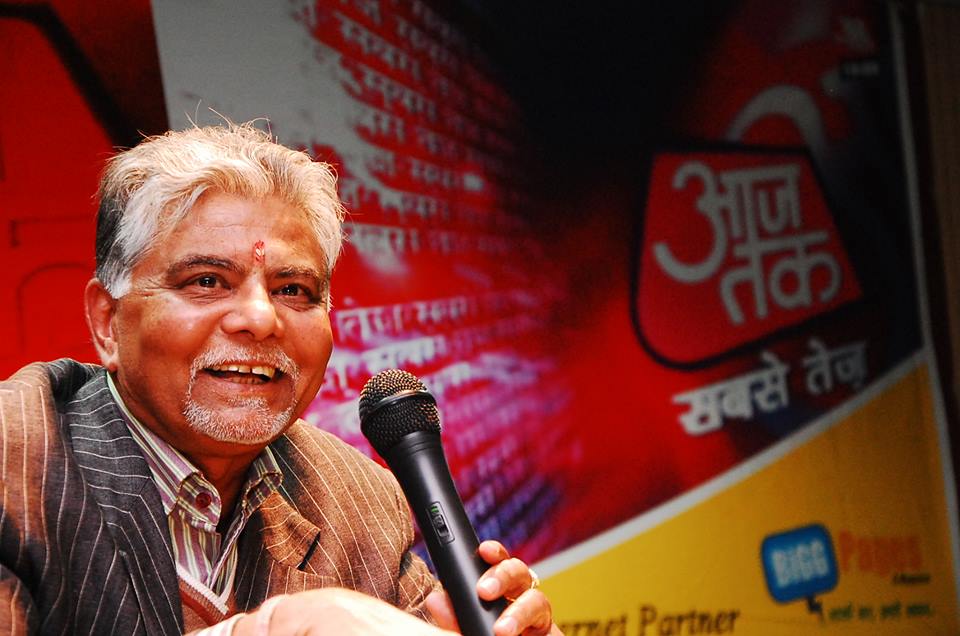बौद्धिक विमर्श और गंभीर बातों को समाचार चैनल और उनके एंकर कितना हल्का बना देते हैं, इसका सबूत बार – बार मिलता रहता है. हाल के दिनों में पाकिस्तान के मुद्दे से लेकर आशीष नंदी और शाहरुख खान तक के मामले में चैनलों पर यही सब दिखाई दिया. बौद्धिक विमर्श और गंभीर परिचर्चा की बजाये टेलीविजन पर सिर्फ तमाशा क्रियेट हुआ. तभी मणिशंकर अय्यर ने कहा कि टीवी के एंकर लोकतंत्र के लिए सबसे बड़ा खतरा हैं. इसी संदर्भ में ‘द हिंदू’ आज एक लेख छपा है जिसे मीडिया खबर के पाठकों के लिए यहाँ प्रकाशित किया जा रहा है.
Death of irony in the age of media
BY Sankaran Krishna
Although Ashis Nandy has explained the context in which he made his corruption remark, the furious pace of TV and Internet does not allow space for a re-evaluation
As I watched the clip of Ashis Nandy, at the Jaipur Literature Festival, belligerently asserting that most of the corruption in India was the work of the Scheduled Castes (SC), the Scheduled Tribes (ST) and the Other Backward Classes (OBCs), I thought to myself: “Okay, what is the sly old fox up to this time?” It was obvious to me that the statement was not meant to be taken literally but rather to make some other point. And sure enough, a few minutes of trawling the web furnished me with an adequate context. Having first pointed out that middle and upper class India’s exclusionary and nepotistic practices have been thoroughly normalised through a discourse of merit and just desserts, Mr. Nandy was asserting that the “corruption” stick was now wielded exclusively when lower castes and other marginalised groups engaged in practices similar to what the twice-born had been doing for centuries. He welcomed such corruption as to him, in a highly unequal and deeply hierarchical society, corruption may be a form of upward mobility for the disadvantaged. With characteristic flourish, Mr. Nandy declared that lower caste corruption gave him faith in Indian democracy and its future.
Irritating reminder
Over the last two years, as much of middle class India awoke to our corrupt ways under Anna Hazare, Arvind Kejriwal and others, Mr. Nandy has been an irritating reminder that (a) the middle class is itself one of the primary beneficiaries of said corruption, (b) that so much of the anti-corruption discourse and punishment are reserved for the lower castes whereas upper caste beneficiaries escape unscathed, and (c) middle class attention to corruption is a direct consequence of its marginalisation as electoral politics based on universal franchise has put it in its place.
As the media circus increased in hysteria, Mr. Nandy has been branded by some as casteist and elitist; still others are demanding his arrest and some have suggested he be tried for sedition. This rush to judging Mr. Nandy has a familiar ring. For a long time now, he has been an insightful critic of India’s much-vaunted secularism. His position is distinct from the critique of pseudo-secularism made by the BJP or the critique of the inadequacies of Congress secularism made by left-liberals. In fact he noted that both communalists and secularists in Indian politics shared a certain instrumental view of mobilising religion to win votes: if the BJP campaigned on the threat to India’s Hindu identity because of minorities, the Congress campaigned on its allegedly singular ability to defend the minorities. In either case, a bit of religious violence was a good thing to garner votes.
Mr. Nandy’s critique of the limits of secularism is best exemplified in a marvellous essay he once wrote on Kochi (then Cochin) and its record of hardly having any communal violence despite comprising sizeable fractions of Hindus, Muslims and Christians. After some fieldwork in Kochi, Mr. Nandy discovered that its communal harmony was not a result of the belief in secularism amongst its residents. Far from it, as most seemed quite unaware of its definition or content. Nearly every Hindu he met “lovingly nurtured” the usual nasty stereotypes about Muslims and vice versa, and people of all faiths heartily detested others of a different faith. What then explained the harmony of the town? Mr. Nandy’s explanation was typical: their tolerance for other faiths came not from an ingestion of Nehruvian secularism (or what Mr. Nandy has often called Indian modernity) but rather from their own lives as practising believers. As Hindus, Muslims and Christians, each of them entertained stereotypes of the other; but as believers, each of them also understood and respected why and how the other could be religious in their own way. It was this tolerance emanating from religious belief that Mr. Nandy considered India’s salvation, not the thin and aseptic secularism of the faithless that her western moderns professed.
Mr. Nandy often illustrated this insight with two observations: first, the three great historical figures that Indians always point to as paragons of tolerance — Ashoka, Akbar and Mohandas Gandhi — did not draw upon secularism; rather they were deeply religious and unlikely to argue for a strict separation of state and religion, or the divorce of ethics from politics. And second, it was in cities, filled as they were with the so-called moderns, that so much of India’s religious violence was concentrated — not in villages, where people were deeply religious and therefore naturally tolerant. Yet, these village Indians were hardly acquainted with the letter and content of secularism. Mr. Nandy’s position on secularism has been an unusual and insightful one — shared with others such as T.N. Madan — but it has often led him to being branded a closet Hindu fundamentalist (which is richly ironic as Mr. Nandy is a Christian, a Brahmo, by birth).
The ‘sati’ controversy
Mr. Nandy has been labelled an anti-feminist/ male chauvinist as well. Many years ago, after a spate of modern day ‘satis’— including the highly visible one of Roop Kanwar in Rajasthan — there was a huge debate and lines were drawn along secular versus communal, traditional versus modern, and superstition versus rational. Mr. Nandy waded in with typical counter-intuition. He pointed out that many latter-day instances of ‘sati’ occurred not amongst traditional rural families but among those moving up a ladder of modernisation and urban employment. He noted that both the so-called secular and communal parties sought to make political capital out of the event, and indeed both were quite comfortable in the deification of Roop Kanwar if they thought it could bring in votes. In that context, Mr. Nandy remarked there was a time in the mythical past when ‘sati’ as an institution said something about honour and valour, and used that to contrast the instrumental and highly modern ways in which ‘sati’ had come to be commodified in post-colonial India. Outrage followed. Mr. Nandy was seen by some feminists as justifying the practice of ‘sati’ and calling for a return to the purity of feudal times.
For those of us who understand Mr. Nandy to be a constant gadfly there is a method in his seeming madness. By exposing the conceits of the moderns he revalorises the traditional and the village. By showing the complicity of the seculars and the communalists in religious violence, he shows how religion has been instrumentalised by all. Both the secularist and the communalist share a deep contempt for the believer (whom Mr. Nandy often describes as both poor and rural in most instances). Many of us also have serious reservations about some of his pet beliefs. Mr. Nandy’s village is closer to the idyllic idealisation of Gandhi and far from the cesspool of superstition and intrigue of Dr. B.R. Ambedkar. He can often seem romantic in his idealisation of the pre- or non-modern, and some of his broad-brush generalisations can be wonderfully free of any empirical specifics. His distinction between pre-modern ‘religion-as-faith’ and a modern ‘religion-as-ideology’ seems too simplistic. And on and on. But which social commentator or scientist, especially one who writes on such large and explosive issues, is free from such critique?
Vastly different mediascape
What is going on with the current brouhaha, however, seems a bit distinctive. Firstly, it occurred on live TV and in a mediascape vastly different from the ones that surrounded ‘sati’ or the debate over secularism. In this era of the sound-bite playing on an endless loop, and a public saturated by electronic media that pervades the remotest village, the time and space for nuance
and distinction seems breathlessly short. Mr. Nandy has explained, as have others, the context in which he made the comment about the SCs, the STs and the OBCs being the most corrupt.
But for those who have rushed to either make political capital out of this ‘insult,’ or just cannot see the irony in the comment, there has been literally neither the time nor the space to conduct a re-evaluation. Positions are instantaneously taken, expressed in public, and then spread like wildfire — making it all the harder to retract. And so the spectacle goes on.
As I ponder over my inability to convince others to see it my way, and they struggle to understand how I could be so obtuse as to miss (to them) Mr. Nandy’s obvious casteism, one thing becomes very clear: it is precisely because neither of us can convince the other of the truth that it is so important to let both of us speak our minds freely. The last word, as always, has to be left to our premier pundit of provocation: Mr. Nandy avers that having been for so long a defender of the lower castes, it would be entirely apt if he were to go to jail for a comment he made on their behalf. While that may appeal to Mr. Nandy’s always over-developed sense of the tragic-comic, it would also represent the descent of our politics into the ludicrous.
(Sankaran Krishna is professor of Political Science at the University of Hawaii at Manoa, USA. Email: Krishna@hawaii.edu)










